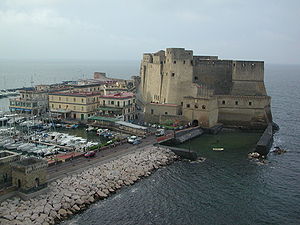- Castel dell'Ovo
-
Coordinates: 40°49′40″N 14°14′53″E / 40.827872°N 14.248012°E
Castel dell'Ovo (in Italian, Egg Castle) is a castle located on the former island of Megaride, now a peninsula, on the gulf of Naples (Southern Italy). The castle's name comes from a legend about the Roman poet Virgil, who had a reputation in medieval times as a great sorcerer, that he put a magical egg into the foundations to support the fortifications.
The castle is connected by a causeway that is a popular place for newlyweds to have their wedding photos taken. The causeway is over 100 metres long. The castle is rectangular in shape (approximately 200 by 45 metres at its widest) and has a high angular bastion overlooking the causeway. Inside the walls are several buildings that are often used for exhibitions and other special events. Behind the castle is a long promontory which was probably used as a docking area. A large round tower stands outside the castle walls to the southeast.
History
The island of Megaride was where Greek colonists from Cumae founded the original nucleus of the city in the 6th century BC. Its location affords it an excellent view of the Naples waterfront and the surrounding area. In the 1st century BC the Roman patrician Lucius Licinius Lucullus built the magnificent villa Castellum Lucullanum on the site. Fortified by Valentinian III in the mid-5th century, it was the place to which the last western Roman emperor, Romulus Augustulus, was exiled in 476.[1] Eugippius founded a monastery on the site after 492.
The remains of the Roman-era structures and later fortifications were demolished by local residents in the 9th century to prevent their use by Saracen raiders. The first castle on the site was built by the Normans in the 12th century. The importance of the Castel dell'Ovo began to decline when king Charles I of Anjou built a new castle, Castel Nuovo, and moved his court there. Castel dell'Ovo became the seat of the Royal Chamber and of the State Treasury. The current appearance dates from the Aragonese domination (15th century). It was struck by French and Spanish artillery during the Italian Wars; in the Neapolitan Republic of 1799 its guns were used by rebels to deter the philo-Bourbon population of the city.
In the 19th century a small fishing village (Borgo Marinari) developed around the castle's eastern wall. This village remains, now known for its marina and restaurants.
References
- ^ This identification was definitively made by Karl Julius Beloch, Campanien (Berlin, 1879), and was accepted by Thomas Hodgkins. Italy and her Invaders (Oxford, 1885), vol. 4 p. 192 n.3
- __ (1992). I castelli di Napoli. Elio De Rosa.
Naples landmarks Albergo dei Poveri · San Francesco di Paola · Cappella Sansevero · Castel dell'Ovo · Castel Nuovo · Certosa di San Martino ·
Gesù Nuovo · National Museum of Capodimonte · Palazzo Reale · Posillipo · San Domenico Maggiore · Santa Chiara · Teatro San Carlo · Galleria Umberto I · Naples CathedralCategories:- Castles in Italy
- Buildings and structures in Naples
- 12th-century establishments
- 15th-century architecture
Wikimedia Foundation. 2010.

